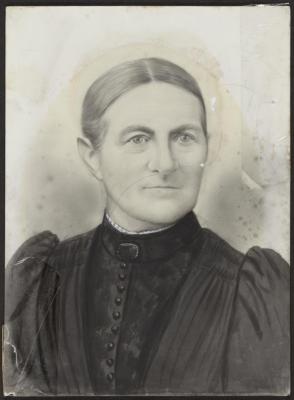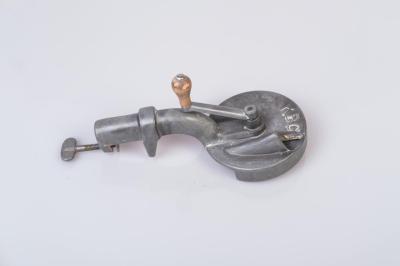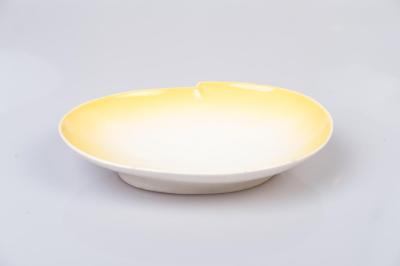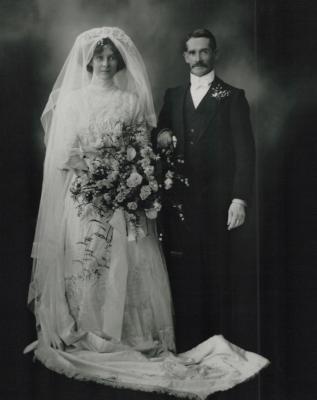PHOTOGRAPH (OPALOTYPE): PORTRAIT OF JOSEPH LAKE
c. 1900Opalotype portrait of Joseph Lake.
Joseph Lake served on the Subiaco Municipal Council from its inauguration in 1897 until 1899.
He became a successful builder, operating from premises next door to his home in Bagot Road, Subiaco. He built Northam High School, branches for the State Savings Banks in Victoria Park and Subiaco, South Fremantle Post Office and the Fremantle Fire Station. Lake Avenue (1st appeared in Post Office Directory 1907) probably named after him
Early days
In 1894, after his Melbourne joinery business partnership collapsed during a severe depression, Joseph took a steamer to Fremantle. He intended to walk to Coolgardie and join the gold rush, but turned back at Northam after meeting a stream of empty-handed diggers who had already tried their luck.
In 1895 he camped in sand dunes near Geraldton while searching for work.
By 1897 he was reunited with his wife, Sarah, and children Hilarie, Laurence and Harold; and had gone into partnership as a builder in Subiaco. On arriving in Subiaco in 1896 Joseph Lake and his family camped in a tent.
Their first house was built on the south-west corner of Rokeby and Barker Roads. It was made of hessian on a wooden frame, the hessian dipped in a cement slurry so it dried firm. The cloth windows swivelled at a point midway down the frame... Harold [Joseph’s son] would later say that his was one of the first half dozen houses in Subiaco. ‘ In 1899 the Lake family moved into their own weatherboard house in Bagot Road, Subiaco.
Joseph built the house, [which] still stands at the corner with Salisbury Road, neat, with thick jarrah axe-hewn floorboards, corrugated iron roof, bull-nose veranda and brick chimneys. In 1908 Joseph bought a block in a sub-division on the beachfront in Cottesloe. By 1911 the family had moved into a large brick and stone house there.
Joseph and his sons continued to work in Subiaco, where Joseph’s business remained. Joseph Lake’s building business folded with the 1930s Depression.
Later generations [of the family] can recall the joinery shop and builder’s yard at the corner of Bagot Road and Rupert Streets in Subiaco... Ralph Lake [Harold Lake’s son] can recall seeing two or three carpenters in waistcoats and ties at their joiner’s bench at this site in probably 1932 or 1933.
In spite of losing the building firm, the Lake family had diversified sufficiently in property, a news agency and other enterprises for the next generation to consolidate their positions and obtain professional education prior to finding paid employment. Harold Lake, Joseph’s younger son, attended school in Subiaco from 1896. Classes at that time were held in a tent. He later went to Perth Boys School and worked at the Commercial Bank in Subiaco.
In 1915 Harold enlisted in the Australian Imperial Force (AIF). After action in France he was awarded the Military Medal.
Harold worked with the family firm after he returned from the war. He married May Ritchie in 1922 and later built a large Edwardian style home on the corner of Cooper Street and Fairway in Nedlands Park, within the City of Subiaco. Laurence Lake, Joseph’s elder son, went into business as a newsagent and stationer in Hay Street, Subiaco, living over the shop with his wife and family until they moved to their new house in Hensman Road.
His son later trained as a pharmacist in Subiaco. This Subiaco story includes extracts and images from ‘Joseph Lake: a Subiaco builder’, a highly commended entry in the 2007 City of Subiaco Local History Awards, and objects donated by the Lake family to the collection of the Subiaco Museum. Copies of ‘Joseph Lake: a Subiaco builder’ are in the reference section of the Subiaco Library (2008 Loc Hist Award entries) and the city's local history collection.
Details
Details
An opalotype is an early photographic technique, used in the mid 19th century and continuing up until around the 1930s.
Opalotypes were printed on white, translucent sheets of glass, known as opal glass.
The technique involved either transferring a carbon print of an image onto the glass, or using a negative to print directly using light-sensitive emulsion applied to the glass.
Some early examples were also hand-coloured.
Historically it is considered a relatively obscure form of photographic imagery, as it was not widely practiced, and production came at a considerable cost.
Opalotypes were also generally reserved for those of considerable wealth as production costs came at a significant cost.
Joseph Lake served as Councillor to the Central Ward of the Subiaco Municipal Council from 1897 to 1899. Lake moved from Victoria to Western Australia in 1894 and was a builder by trade, responsible for the construction of many notable buildings in the Perth region including the Fremantle Fire Station and branches of the State Savings Bank in Subiaco and Victoria Park. In 1898 he built and lived at a house on the corner of Bagot Road and Salisbury Street, which still stands today.
Joseph Lake and wife, Sarah Lake, had three children, Hilarie, Laurence and Harold
High local significance: early Subiaco settlers and member (ie Joseph Lake) of Subiaco Muniicipal Council 1897 - 1899
Social:
Aesthetic:
Historic:
Provenance:
Rarity:
More items like this
Other items from Subiaco Museum
- BEAN CUTTER: METAL
- BOWL: WEMBLEY WARE, YELLOW AND CREAM ASYMETRICAL
- PHOTOGRAPH: VIEW OF SHENTON PARK LAKE AND SURROUNDS
- PHOTOGRAPH: WEDDING PORTRAIT OF MISS PHILP AND MR DENNIS
- PHOTOGRAPH: MRS DENNIS
- PHOTOGRAPH: WEST SUBIACO METROPOLITAN JUNIORS FOOTBALL TEAM 1932
- PHOTOGRAPH: WEST SUBIACO FOOTBALL CLUB, 1924









